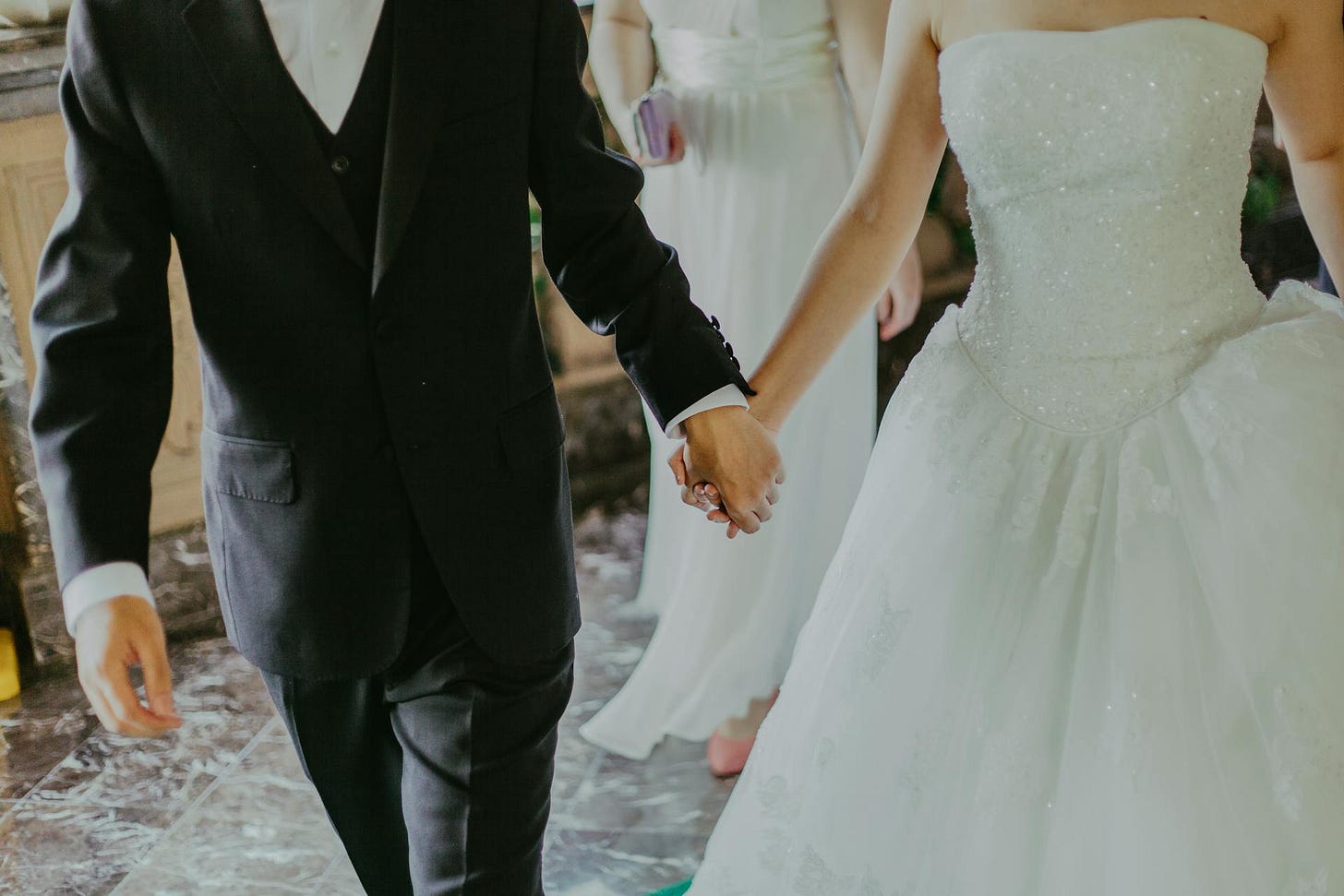A recent Atlantic article laments the decline in marriage rates.1 Since 2010, the marriage rate has held steady at around 31 women married in the last year per one thousand unmarried women.2 This is down from 68.2 in 1900. The Atlantic article suggests the explanation is as follows: “Coupling is declining around the world, as women’s expectations rise and lower-income men’s fortunes fall; this combination is subverting the traditional role of straight marriage, in which men are seen as necessary for the economic insurance of their family.” There may be a lot of truth to this—socioeconomic prospects deeply impact people’s choices about marriage. But as intriguing as that sociological story sounds, I would like to suggest a much more basic, less philosophical explanation for the decline in marriage rates: weddings are too expensive. Faced with the extreme investment of time and money required for marriage, young couples are simply choosing to defer a wedding either until their finances improve, or just indefinitely.
The Numbers
So how much money, time, and planning goes into a wedding? Let’s go through the numbers.3 Engagement comes first. The majority of couples (57%) typically spend more than a year discussing engagement before they actually get engaged. Once they finally do decide to get engaged, most couples get an engagement ring. The average engagement ring costs $5,200. The engagement lasts (on average) 15 months before the wedding happens.
Engaged couples spend an average of 6 hours a week on wedding planning. The average age of marriage in 2023 was 32, and at that age the average hourly salary is roughly $27/hour. Thus, this works out to be about $162 per week. If the average engagement is 15 months (65-ish weeks), that’s about $10,500 of time. However, since they probably wouldn’t have been working during this time if they weren’t engaged, we won’t count it in our equation. But it’s still a lot of time-value.
Couples also need to plan for (or find someone to plan) a shower, as well as bachelor and bachelorette parties. The average cost per person for bachelor and bachelorette parties is over $1000. So that’s $2000 total for that. Additionally, couples need to plan a honeymoon, which costs an average of $5,300.
Then there’s the actual wedding, which has an average of 131 guests if you’re from “Gen Z” and 113 if you’re a Millennial. The average wedding costs $33,000. On average, couples pay about half of that (so $16,500).
Thus, by my math, getting engaged and then married costs an average of $29,000 (not including the time-value of the 6-hrs/week of planning).
But it doesn’t stop there. Married couples also like to buy homes. First-time home buyers have a median age of 38, which doesn’t line up with the average age of marriage (32), so it seems couples usually wait longer to buy a house. But that’s what actually happens. I think we’d all prefer to live in a world where newlyweds could afford a house. So what does it actually cost to buy your first house? First-time home buyers pay an average of 9% as a down payment. For, let’s say, a $250,000 house, that’s $22,500, and then payments on the mortgage every month thereafter.
All told, we’re looking at around $51,500 just to get married and buy a house. At age 34, the median checking and savings account balance is an impressive . . . $5,400 (although the average is much higher, presumably due to outliers on the high end).4 So good luck making a wedding happen.
The Problem
This has straightforward negative consequences: young people are financially unable to get married. If we value marriage as an institution, we aren’t doing a good job of incentivizing young people to participate in it.
So why such a big price tag? Weddings cost so much and involve such exertion of labor because most couples expect perfection and extravagance at their wedding. Everything has to be just right, the venue has to be perfect, the dress has to make people jealous, the food must be delicious, the photos should be stunning, the getaway car needs to be a Mustang, etc., etc. Surely the internet is partly to blame—no longer do young couples (and, let’s be honest, young women) compare their weddings to those they’ve personally attended (which in many cases is just a handful), but now they compare their wedding to the thousands of gorgeous weddings plastered all over the internet. On top of this, it’s also likely that infrequent weddings create a negative feedback loop: weddings are less common, so they are more exciting, so the standards are higher, so they cost more, so there are less weddings.
But whatever the causes may be, weddings have become too expensive. Young people simply can’t afford to get married.
Lest you think this all overblown, I will remind you that, apparently, the average cost of a wedding in 1939 was $392.30.5 In today’s dollars, that equates to about $8,965.64. That’s just over a quarter of the average cost of a wedding today. That price is much more attainable for a young couple who’s in love.
We don’t live in that world anymore.
Conclusion
But maybe we should. It’s fine to want a nice wedding, but for the sake of marriages, we need to collectively lower our expectations. What if we went back to using churches instead of $10,000 venues? What if we had chicken and potatoes with sparkling water instead of steak and fettuccine and wine? What if we got that photographer-cousin to take the photos for half the price? What if honeymoons were shorter and cheaper? What if we dispensed with extravagant bachelor(ette) parties? Of course these amount to nothing more than random thoughts, but we must figure out some way to make weddings cheaper. Our youth need it. Our species needs it.
Unless otherwise noted, all modern wedding data is taken from The Knot, and all modern financial data is taken from NerdWallet.




